In this article, you get a lot of information about in-the-ear hearing aids. If you like them or not is also highly dependable on how the shape of the hearing aid is built and how it fits your ear in combination with your hearing loss. All these variables lead to how you hear and how you perceive your own voice.
How Much Do in-the-Ear Hearing Aids Cost?
The cost of in-the-ear hearing aids starts at about 1000¢ and can be up to 6000€. The prices are formed by more extensive functions or other materials. A hearing aid made of plastic is always cheaper than an in-the-ear hearing aid made of titanium. So the price range is quite wide and doesn’t tell you much at first. It is best to read on and learn more about how the devices differ and what you can get from them.
Disadvantages of in-the-Ear Hearing Aids
- In-the-ear hearing aids are smaller and can be more difficult to handle if you have limited motor skills.
- The choice of which battery to select is somewhat less.
- The possible design depends on the shape of your ear canals.
- Possibly a stronger perception of your own body sounds. (The own voice, running, chewing…)
- Lack of ventilation of the auditory canal
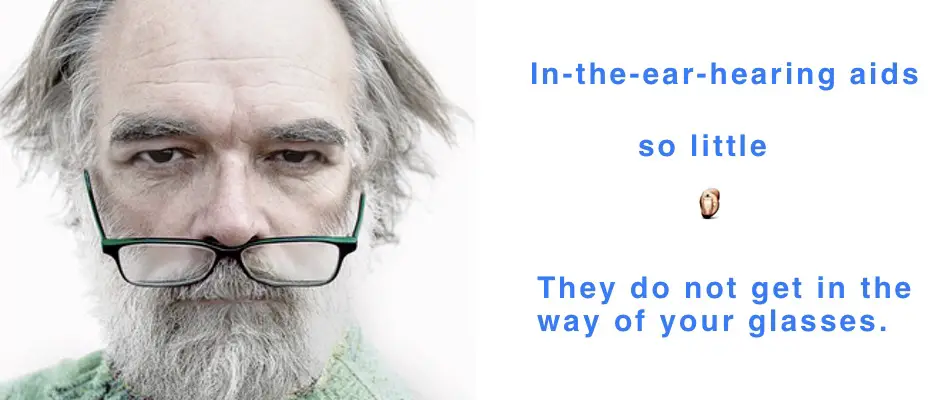
Advantages of in-the-Ear Hearing Aids
- Less visible than hearing aids that sit behind the ear
- Make phone calls as usual. You simply hold the receiver of the phone to your ear. You can’t do that with hearing aids that sit behind the ear. Find out more here.
- The way of hearing is more natural. Pinna effects don’t have to be factored in.
- No rustling of hair on the microphones compared to behind-the-ear hearing aids.
- Easier selection when wearing glasses. The temples of the glasses have no contact with the hearing aids.
- Perfect performance of the hearing aid due to the anatomical fit.
For Whom Are in-the-Ear Hearing Aids Suitable?
Visually, in-the-ear hearing aids are suitable for you if you are looking for a discreet solution. The ear should not be excessively moist, otherwise, the technology could suffer. Moisture is in fact one of the biggest factors for defects in hearing systems.
There is a simple trick you can use to test whether you can tolerate in-the-ear hearing aids. Simply cover your ears with your fingers. Now speak a little. Make A, E, I, O, and Us sounds. In fact, in some cases, using an in-the-ear hearing aid produces a similar occluded effect.

This so-called occlusion effect can cause you to perceive your body sounds and voice somewhat differently. Usually louder and more clearly. As hearing care professionals, we then have the option of inserting an additional hole that significantly reduces this effect. However, the hearing system usually loses some of its performance with the additional hole called a vent.
Another point we check during the fitting of in-the-ear hearing systems is how your ear canal deforms or whether it is relatively static. Some of our clients have an ear canal that becomes extremely deformed when they chew or speak, for example. The lower jaw can cause severe deformation of the ear canal.
With clean hands, put your little finger in your ear once and make chewing movements. If you feel the lower jaw bone strongly, it may be that your audiologist will pay special attention to this in the fitting and optimize the shape of the in-the-ear hearing aid directly in advance.
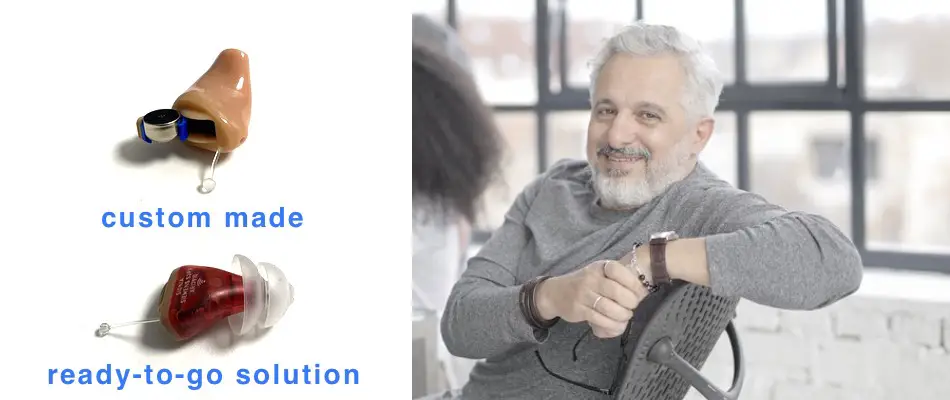
In a few cases, however, a severely deforming ear canal also means that the hearing instruments can move too much and fall out. This is because some people have a very straight ear canal, while others have a more angled one. As you can see, there are significant differences. Your audiologist will be happy to advise you on this.
Experience With in-the-Ear Hearing Aids
In our shop, we fit in-the-ear hearing aids daily. The non-custom ones like the Signia Silk as well as the custom ones like the Phonak Virto for example. For you as a potential wearer, it is important to know the options the hearing aid comes with. For example, you can order the Phonak Virto with Bluetooth, with a telecoil, with a longer-lasting 312 battery and directional microphones. Directional microphones can enhance the understanding of speech in a noisy environment.
But when you opt for the smaller shape of the hearing aid you can not go with Bluetooth, nor directional microphones, nor telecoil and also only with the smaller 10 battery size. You can get a great experience with the smaller ones as well as the bigger devices as long as the feature set and the amplification meets your needs.
Your audiologist will guide you with his experience with in-the-ear-hearing aids. Because he or she knows what is compatible let us say with your mobile or with the devices you already own. I had customers in the past that really wanted to use some features who had no access to them because of the missing compatibility of their mobile phones with the hearing aids.
In-the-Ear Hearing Aids Comparison
Of course, there are big differences between in-the-ear hearing aids. We have given you a small comparison of in-the-ear hearing aids in the table below. Some hearing aids (more likely to be found in the Basic category) provide good speech understanding and are already quite sufficient for a quieter lifestyle.
Other hearing aids optimize the sound, for more comfort during a lot of and loud ambient noise, for example in an open-plan office. Once you leave this situation and want to make a phone call, you can also take calls directly through the in-the-ear hearing aids or adjust the sound of the hearing aids via an app. Feel free to take a look at our comparison.
| Basic | Comfort | Premium | High End | |
| Is a tinnitus program possible? | ✔ | ✔ | ✔ | ✔ |
| Automatic program change | ✔ | ✔ | ✔ | ✔ |
| Speech understanding in a quiet environment | ✔ | ✔ | ✔ | ✔ |
| Understanding speech in noisy environment | ✔ | ✔ | ||
| Channels quantity | 8 | 12 | 16 | 20 |
| Optimization for music | ✔ | ✔ | ✔ | ✔ |
| Bluetooth | ✔ | ✔ | ✔ | |
| Optimization of speech from all directions | ✔ | ✔ | ||
| Comfort in echoing situations | ✔ | |||
| Speech understanding with driving noise | ✔ | |||
| Rechargeable battery | ✖ | ✖ | ✔ | ✔ |
In-the-Ear Hearing Aids for Severe Hearing Loss
In-the-ear hearing aids can also be used for severe hearing loss. Here it is important to say that slightly larger components also lead to a larger design. The reason is that there are different receivers, which differ in their power.
It is obvious that a more powerful receiver is more likely to be used in cases of profound hearing loss. Higher power also tends to drain your batteries a little faster, which is why we recommend a minimally larger battery to avoid too frequent changes. In short, there are of course very powerful hearing instruments.
The most powerful hearing systems fall into category WHO 4. In this category, the most severe hearing impairments are compensated with the hearing systems. In-the-ear hearing systems can no longer compete in this field. However, only a very small percentage of hearing aid users need such strong hearing support.
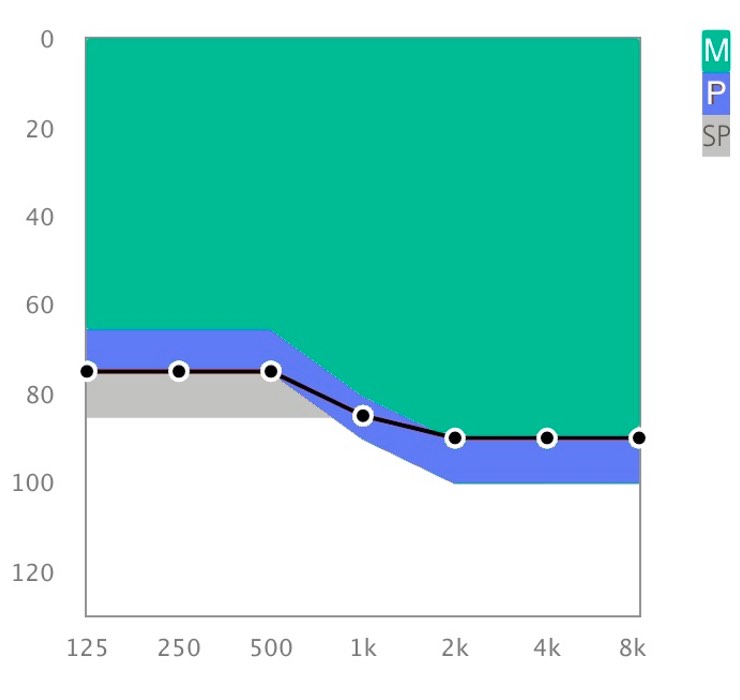
In the picture above, you can see the power specifications of the different receivers for in-the-ear hearing aids. You can see the pitches at the bottom on the horizontal axis. On the vertical axis you have the amount of amplification needed until you start to hear something.
The letters M,P, SP, and the associated colors demonstrate the maximum possible power. It is important to know that if a hearing aid has certain technical data, this does not mean that this power must also reach you in exactly the same way. Hearing canals are different in length and shape.
Of course, we check this during the fitting process to give you the best possible speech understanding. For example, many of our customers find the SP receiver to have a “richer” and more natural sound. As you can see, this is also directly reflected in the audiogram. The SP receiver gives you more amplification and volume when it comes to lower tones.
We therefore recommend installing the largest possible receiver that fits your ear canal. Not only will it not reach its performance limit as quickly, but it will also make music lovers’ hearts beat faster compared to the smaller, less powerful earpieces with a flatter and less voluminous sound.
In-the-Ear Hearing Aids and Bluetooth
Technology has, of course, also advanced for in-the-ear hearing systems and Bluetooth is definitely available for you to order. The Virto M from Phonak is a good example of this. It is powered by a 312 battery (rechargeable batteries are NOT YET available for order) and allows you to connect directly to your cell phone or your TV. So you don’t need any devices in between for this.

In addition, you can also change the settings of your hearing aids directly via an app on your phone to your liking. Do you want a special program that you have configured individually for you from the sound? No problem. Want to use your phone as a remote control to change the volume or the orientation of the microphones? No problem. All this is possible.
In-the-Ear Hearing Aids for Tinnitus
In-the-ear hearing aids can also be worn if you have ringing in your ears, such as a whistling sound or noise. Manufacturers offer special settings within their programs for tinnitus. There are different approaches to this. In some cases, the disturbing sound is “washed around” with ambient noise so that it is no longer so prominent.
Other settings “mask” the sound.
The Ventilation in in-the-Ear Hearing Aids
There should be sufficient ventilation in your ear canal. For some hearing aid users, this means that we place a ventilation hole to provide air exchange in front of and inside the ear. This is not always necessary. However, humidity plays a big role in this.
If there is a lot of moisture in the ear, it may be better to use hearing instruments that sit behind their ear. The reason is that the moisture does not stress the technology as quickly.
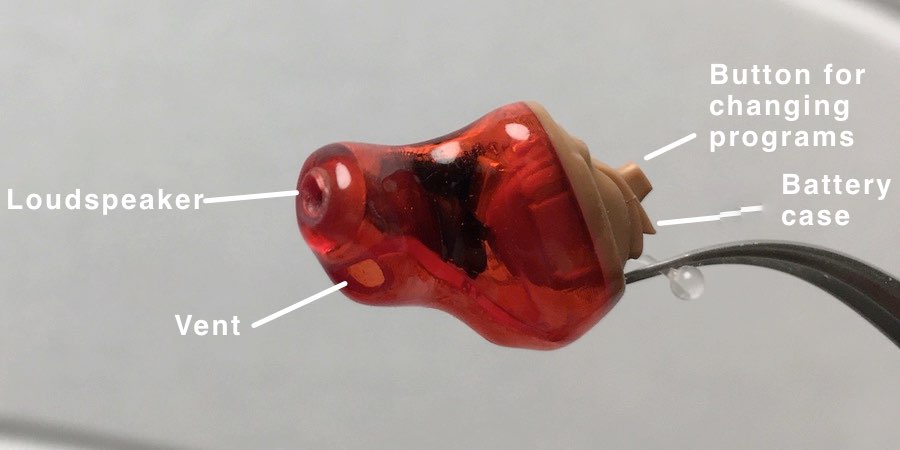
In-the-Ear Hearing Aids With Rechargeable Battery
Currently, there are the Active and Active Pro in-the-ear hearing aids from Signia and the Livio AI from Starkey, which are equipped with rechargeable batteries. These devices not only sit in the ear canal but also line the pinna. For this reason, the vast majority of hearing aid users still stick with in-the-ear hearing aids with batteries.
In the picture below, we have shown on the left a very small in-the-ear device that runs on batteries compared to the Signia Active, which has a rechargeable battery.
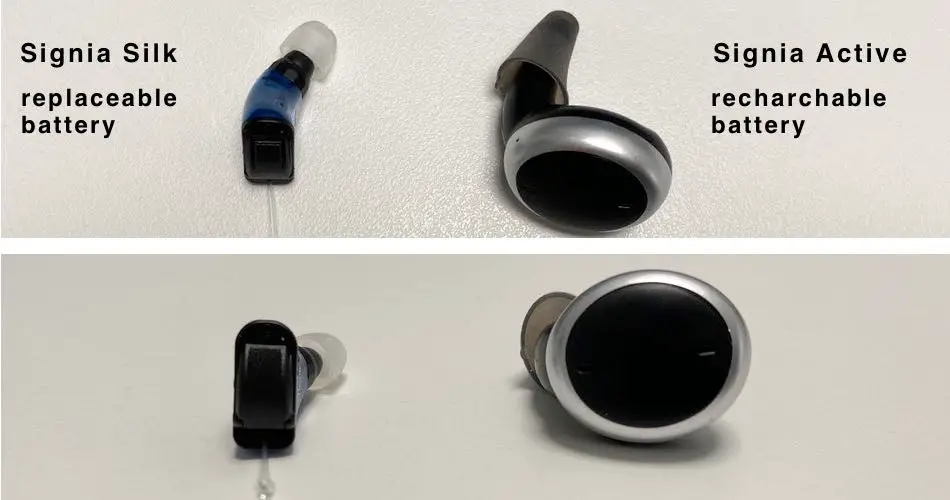
Here below in the picture you can see the size difference a little more vividly, right in the ear. Hearing aid wearers with in the ear devices (CIC) this small will probably never respond to the hearing aids. With battery devices, here you have directly a visible device in the ear.

Possible Materials From Which an in-the-Ear Hearing Aid Can Be Made
- Titanium
- Acrylic
- Wood
- Gold
- Silver
The most common materials are acrylic and titanium. The advantage of titanium is the extremely high strength of the material. For this reason, the outer walls of the in-the-ear hearing aid can be made somewhat thinner. This creates more space for the technology in the hearing aids.
CROS Hearing Aids as an in-the-Ear Solution
Cross fittings can also be implemented as in-the-ear hearing aids. However, the choice is a little more limited when it comes to the size of the hearing instruments. The signal is then transmitted from one side via radio to the hearing system of the other.
BiCROS fittings can also be implemented in this way. Among the manufacturers, Widex, Audio Service and Phonak are particularly suitable.
Which in-the-Ear Hearing Aids Are the Best?
Which devices suit you best should emerge during the consultation. However, Phonak’s custom Virto™ Marvel 90 offers the most technically advanced in-the-ear hearing aid on the market today. You can pair it with almost any smartphone and have the widest range of accessories available.
Whether you need it, and whether it’s best for you, remains to be seen. However, we are enthusiastic about this in-the-ear hearing aid.
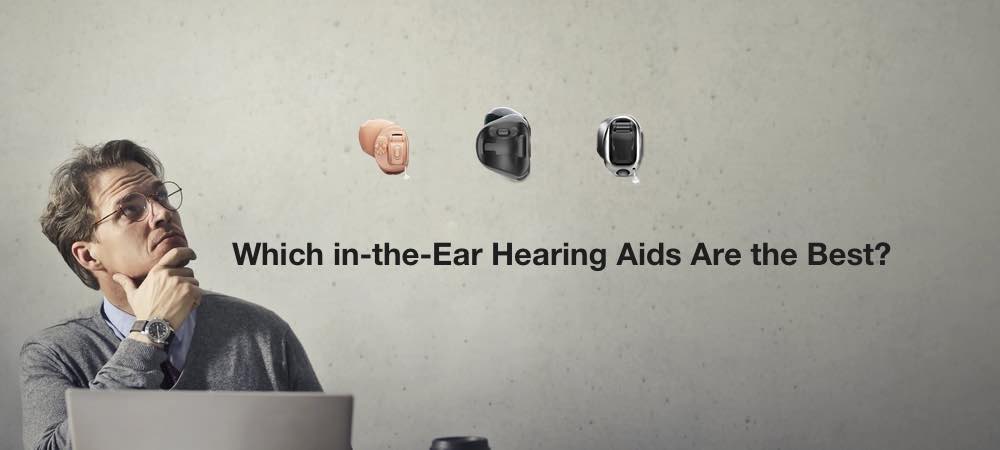
In-the-Ear Hearing Aids With Remote Control
For the in-the-ear hearing aid models Conchaform, Canal in the Ear hearing aids, a remote control can always be ordered as an option. CIC and IIC designs rarely allow remote controls.
Cheap in-the-Ear Hearing Aids
Less expensive in-the-ear hearing aids refer to entry-level devices that allow you to make basic program settings. Your hearing loss is of course compensated just as well with these inexpensive devices as with higher quality ones. The price of inexpensive in-the-ear hearing aids is around 400€ per hearing aid.
The Cleaning of in-the-Ear Hearing Aids
Like any other hearing aid, in-the-ear hearing aids should be cleaned regularly. This is because dander, cerumen (earwax) and moisture can clog microphones and speakers.
Daily care involves disinfecting and briefly viewing the hearing aid each day after wearing. When viewing, check the openings on the hearing aid to see debris and remove it with a small brush or cloth.
Afterwards, the device is ideally placed in a drying box. This provides protection against moisture and thus removes one of the main reasons for repairs and defects in hearing instruments. Many of these drying boxes also emit UV light to kill germs.
Depending on your needs, you may have to change wearing parts of the hearing system. These are mainly the filters that are mounted in front of the speaker of the hearing instrument. The reason for the change is that the filter becomes clogged and deposits are formed on it. If the filter is clogged, the amplification no longer reaches your ear.
These wear parts are changed with a simple click. The additional costs for this are included in the service flat rate of the health insurance. So you don’t have to pay anything extra for this.
What Are the Options When in-the-Ear Hearing Aids Whistle?
If your hearing aids whistle, amplified sound is escaping from your ear canal and being amplified again by the hearing aid. This results in a loud annoying whistling sound (feedback). There are two ways to eliminate the problem.
- Your hearing instrument seals better (new shell or mold).
- The problem is fixed via the software
If the problem is fixed via the seal, the sound can no longer get out and you will have the best possible hearing aid performance with optimal settings. Of course, a new shell may be associated with cost. The fit could also be negatively affected by hairs in the ear canal. It should be clarified in advance whether a simple removal of the hairs can not already solve the problem.
The second free and quick solution is to control the feedback problem via the software. Via this, the software detects the whistling sound and usually turns it off very effectively. The disadvantage that often arises is that the gain in the high frequencies is turned down. (So you don’t understand as well because the hearing aid isn’t performing as well as before).
Which in-the-Ear Hearing Aids Are Invisible?
The smallest in the ear hearing aids are called IIC. The abbreviation stands for invisible in the canal. These sit deep in the ear canal and are not noticeable at all to most lay people. Such a small design naturally comes with frequent battery changes. The reason is that significantly smaller batteries are installed to achieve the small size.
Are in-the-Ear Hearing Aids Suitable for Sports?
You can wear your in-the-ear hearing aids during sports without any problems. The ratings for splash water protection are given. Especially if you are very active, it can be useful to put your hearing aids in a drying box overnight. This will protect your hearing aids in the long run from necessary repairs or moisture ingress.
Please keep in mind that splash protection is not the same as waterproof. Submerging the hearing instruments under water would most likely damage them or at least degrade the function until dry.
Are in-the-Ear Hearing Aids Waterproof?
In-the-ear hearing aids are not waterproof. Although these hearing aids have an IP 58 to IP 68 certification, the manufacturers themselves advise against immersing the hearing aids. The reason is that microphones and speakers are in contact with the air.
If these are washed around with water, this can lead to the microphones having to be dried for a longer period of time because water has settled at the narrow points. In addition, battery doors always offer the risk that moisture can penetrate the hearing instruments. For this reason, the following applies: Remove the hearing aids from the ear before showering.
In-the-Ear Hearing Aids and the Accessories
Accessories for in-the-ear hearing aids now include TV connectors, table microphones, remote controls, apps, clip-on microphones and telephones. When selecting your new hearing system, we are of course happy to pay attention to desired additional devices. These accessories can become especially important for you if you are actively at work. Here, a table microphone or the TV Connector can make listening to a presentation much easier.
In most cases features like streaming is only available in combination with the bigger in-the-ear hearing aids. The smallest ones can often times not be used with additional microphones or streamers.
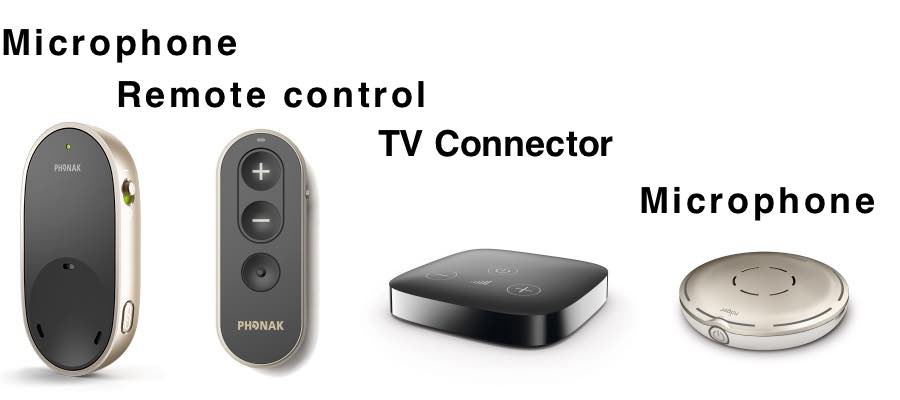
What Are the Options if the in-the-Ear Hearing Aid Slips?
We take a very close look at the ear canal. There are very angled ear canals and rather straighter ear canals. The in-the-ear hearing aid needs certain support zones to sit evenly in your ear all day. The deeper the hearing aid sits, the less it is affected by movements of the lower jaw when speaking or chewing.
The front part of the ear is softer and moves more or less depending on the hearing aid user. Deeper in the ear, however, nothing moves because that is where the bony part of the auditory canal is found. It may therefore make sense to switch to a different in-the-ear design to produce a smaller hearing instrument that can be inserted deeper.
However, it may be possible to improve the problem of the hearing instrument slipping out with the same design if it fits better. When an impression of your ear is taken, the impression may vary in shape. This is because of different materials that can be used for this. Some are a little more fluid and others are a little more solid.
Just imagine the following: You have a slightly firmer material injected into your ear with a little more pressure. You are sitting down and the pressure deforms the ear minimally as the material is delivered. However, for comparison, you could also position your head on the table. If a very fluid material were used here, no pressure would have to be used at all and the shaping of the impression would be different on the cartilaginous part of her ear.
Here then nothing has changed, widened or expanded. However, it is of course unusual to position the head on the table. For this reason, it is done less frequently. We as hearing care professionals can also take several impressions to evaluate your jaw position. This depends on your individual anatomy.
It could also simply be that the hearing aid no longer has an even fit due to increased hair growth and therefore slips. Removing the hairs in the ear canal then quickly leads to more hold. In addition, adhesive coatings can also be applied to acrylic in-the-ear hearing aids that can prevent slippage. As you can see, there are several options.
Speak to your audiologist. He will explain what option to look for in your case.
I wish you a great day.
